#battle of legnica
Explore tagged Tumblr posts
Text

Henry II the Pious departing for Legnica by Jan Matejko
#henry ii the pious#battle of legnica#art#jan matejko#battle of liegnitz#middle ages#medieval#knights#knight#silesia#silesian#poland#polish#history#christianity#christian#europe#european#castle#portcullis#gate#castles#legnica#henry ii#lower silesia#armour#shield#cross#heraldry#horses
242 notes
·
View notes
Text
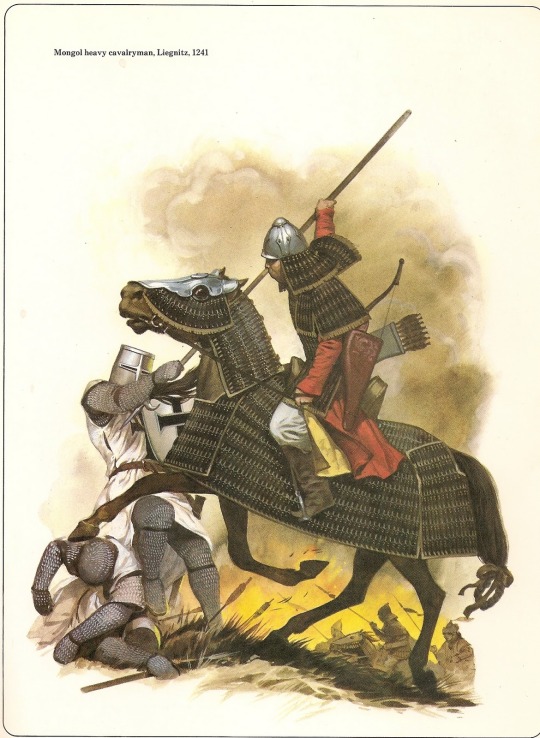
SPOTLIGHT ON THE SIGNIFICANCE OF HEAVY MONGOL CAVALRY IN BATTLEFIELD STRATEGY.
PIC INFO: Spotlight on a Mongol heavy cavalryman, Liegnitz (present day Legnica, Poland), c. 1241, the Mongol Empire. Artwork by the late, great Angus McBride.
OVERVIEW: "While a standard Mongol army did field a large number of horse archers, entire battles couldn’t be won by just one tactical arm of the force. In fact, almost equally (if not more) crucial was the Heavy Cavalry that was tailored to counter-attacking maneuvers. These heavy horsemen were mostly armored in Asiatic lamellar style where scales of metal (or hardened leather) were sewn together through tiny holes.
PART II: Sometimes entire coats were reinforced with metallic pieces – and they were possibly worn beneath dedicated armor systems for added protection, thus alluding to super-heavy cavalry units. Similarly, helmets were crafted from larger iron pieces, but they characteristically featured extended neck guards made of metallic bits. And as for arms, most of these heavy horsemen used lances, possibly both in couched and overhead positions."
-- REALM OF HISTORY (Dattatreya Mandal, February, 10, 2016)
Source: http://miniaturasmilitaresalfonscanovas.blogspot.com/2012/02/angus-mcbride-los-mongoles.html.
#Mongol Cavalry#The Mongols#Mongols#Mongol Warfare#Heavy Cavalryman#Osprey Publishing#Angus McBride Art#Mongol Empire#Mongol Heavy Cavalry#Mongol Heavy Cavalryman#Leignitz#Heavy Cavalry#Mongol Army#Legnica#Legnica Poland#Mongol Warfare History#Military History#Mongol Empire 1241#Angus McBride#The Mongol Empire#Cavalryman#Illustration#World History#The Mongols Osprey Publishing#1200s#Mongol Invasion of Europe#1241 A.D.#1241#Central Asia#Mongol Cavalryman
3 notes
·
View notes
Text
Events 8.26 (before 1900)
683 – Yazid I's army kills 11,000 people of Medina including notable Sahabas in Battle of al-Harrah. 1071 – The Seljuq Turks defeat the Byzantine army at the Battle of Manzikert, and soon gain control of most of Anatolia. 1278 – Ladislaus IV of Hungary and Rudolf I of Germany defeat Ottokar II of Bohemia in the Battle on the Marchfeld near Dürnkrut in (then) Moravia. 1303 – Chittorgarh falls to the Delhi Sultanate. 1346 – At the Battle of Crécy, an English army easily defeats a French one twice its size. 1444 – Battle of St. Jakob an der Birs: A vastly outnumbered force of Swiss Confederates is defeated by the Dauphin Louis (future Louis XI of France) and his army of 'Armagnacs' near Basel. 1542 – Francisco de Orellana crosses South America from Guayaquil on the Pacific coast to the mouth of the Amazon River on the Atlantic coast. 1642 – Dutch–Portuguese War: Second Battle of San Salvador: The Dutch force the Spanish garrison at San Salvador (modern day Keelung, Taiwan) to surrender, ending the short-lived Spanish colony on Formosa and replacing it with a new Dutch administration. 1648 – The Fronde: First Fronde: In the wake of the successful Battle of Lens, Cardinal Mazarin, Chief Minister of France, suddenly orders the arrest of the leaders of the Parlement of Paris, provoking the rest of Paris to break into insurrection and barricade the streets the next day. 1748 – The first Lutheran denomination in North America, the Pennsylvania Ministerium, is founded in Philadelphia. 1767 – Jesuits all over Chile are arrested as the Spanish Empire suppresses the Society of Jesus. 1768 – Captain James Cook sets sail from England on board HMS Endeavour. 1778 – The first recorded ascent of Triglav, the highest mountain in Slovenia. 1789 – The Declaration of the Rights of Man and of the Citizen is approved by the National Constituent Assembly of France. 1791 – John Fitch is granted a United States patent for the steamboat. 1810 – The former viceroy Santiago de Liniers of the Viceroyalty of the Río de la Plata is executed after the defeat of his counter-revolution. 1813 – War of the Sixth Coalition: An impromptu battle takes place when French and Prussian-Russian forces accidentally run into each other near Liegnitz, Prussia (now Legnica, Poland). 1814 – Chilean War of Independence: Infighting between the rebel forces of José Miguel Carrera and Bernardo O'Higgins erupts in the Battle of Las Tres Acequias. 1833 – The great 1833 Kathmandu–Bihar earthquake causes major damage in Nepal, northern India and Tibet, a total of 500 people perish. 1849 – President Faustin Soulouque of the First Republic of Haiti has the Senate and Chamber of Deputies proclaim him the Emperor of Haiti, abolishing the Republic and inaugurating the Second Empire of Haiti. 1863 – The Swedish-language liberal newspaper Helsingfors Dagblad proposed the current blue-and-white cross flag as the flag of Finland. 1883 – The 1883 eruption of Krakatoa begins its final, paroxysmal, stage.
0 notes
Text
1241 - Simply speaking, this battle is a part of the story of when the Mongols tried to conquer Europe. Hear how the tactical expertise of the Mongols measured up to a European army.
#legnica #mongolempire #europe #medievaleurope #europeanhistory #silesia #poland #polandhistory #liegnitz #wahlstatt #templars
0 notes
Text
Not fantasy, but I feel like shows like Space Battleship Yamato (reboot, 2199 specifically), Babylon 5 and Legend of the Galactic Heroes does these tactics stuff pretty well.
I’ll only write one of them here since it’s a long one
Legend of the Galactic Heroes. There’s so much combat here that to be anything other than have tactics constantly is stupid. Both the FPA and the Empire have tactics. And not only tactics, but political tactics. The best ones are from My Conquest is the Sea of Stars in my opinion.
In MCitSoS, Reinhard is coming to Iserlohn, his fleet has had a long trip and Iserlohn was already preparing an intercept fleet for the forces at Legnica (a gas planet near Iserlohn) however Muckenberger, the Chief Commander of the Space Fleet doesn’t want to deal with him. Despite the fact they were already preparing an intercept fleet, he orders for Reinhard’s fleet to redirect instead.
They even insult him while he’s away, they don’t believe in his abilities! And yet he comes back unscathed and it’s incredible. They call it a fluke naturally and prepare for the next battle where they have to protect Iserlohn.
Which leads us to this:

Muckenberger’s sending Reinhard and his fleet in alone, intending to sacrifice the man which falls under the whole “this commander is an idiot” however logically it was sound to him and this is important because it’s perspectives. To him, sacrificing Reinhard would mean absolutely nothing negative to him even if the man is favoured and he’d have gotten rid of a man he hated.
And yet Reinhard subverted his expectations, seen in the gif as Reinhard does a ballsy move of turning between the two fleets and going out the right side out of combat. This still could have prompted enemy attack and yet it didn’t (plot reasons sure) but it showed Muckenberger to be a fool.
And then afterwards:

This use of “brat” showing he still hates the idea of even letting Reinhard take some glory for himself, or even help despite how badly his own fleet needs it.
But due to this help, the FPA gets into trouble, they throw out a diversion fleet. The Baron (on Muckenberger’s right during the second gif here) sees this as their escape being cut off. But Muckenberger, the actual soldier, sees this as an attack on Iserlohn, the Fortress they’re meant to be defending from enemy forces.
So he falls for it, who wouldn’t! Your base gets attacked why shouldn’t you immediately divert to deal with it? However since he fell for the diversion, his fleet now gets into trouble, which forces Reinhard’s hand to divert some of his Battleships to deal with the fleet, and what does he send?

Instead of going off at his superior officer or claiming him an idiot (like movies would do) he instead goes blunt and simple.
And it gets Muckenberger’s respect! You can see him go from frowning to smiling a bit. He’s impressed and it really makes me want to go into detail about this arc of respect he gets to Reinhard because on any other movie that’s modern, the superior would have ignored it. It’s an inferior officer after all why should he care.
But this is why I love Legend of the Galactic Heroes, there’s character growth with the commanders. They’re not one-dimensional “I know better than you” commanders, especially Muckenberger here.
It’s just one of the few older shows that actually explore good commanders and write “bad” commanders very well that either stay very bad and stupid or grow to be a better one and it’s why I endorse the show and sing high praises.
the problem with knowing things about battle tactics is that an ever-increasing subset of popular media becomes impossible to enjoy properly because you have to sit there like 'wow Captain Protagonist good to know all those dead people on your own side are a direct result of your total lack of anything resembling brains'
#long post#kalani does an essay#lotgh#logh#Legend of the Galactic Heroes#ginga eiyuu densetsu#i just really want more people to look at original series it's so good#this post was already really good#i just started writing part of an essay into the tags previously before i reblogged and then went 'fuck it essay time in actual writing'#thank you op for letting me make a random ass essay that i wrote in like 2-3 hours#will anyone read this long ass post probably not but ey it was good to do something productive for once!#military stuff#tactics explanation
15K notes
·
View notes
Note
"Hm? You look familiar. Did I fight you?"
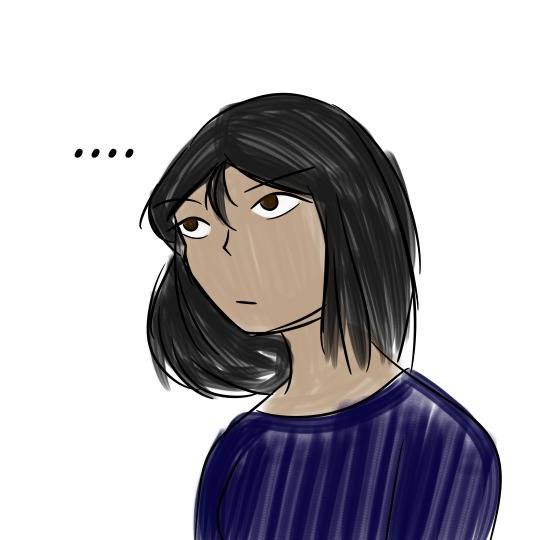
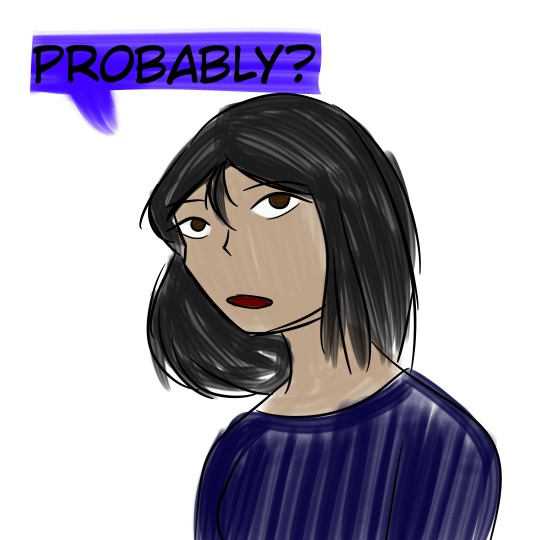
"You are going to need to be more specific. I've fought many different people and nations."
"But perhaps the Battle of Legnica might be what you're thinking of?"
@ask-the-awesome
#aph mongolia#nyotalia#hetalia ask blog#hetalia#nyo!mongolia#drawn response#interactions#nyo mongolia#sükh sarangerd#ask-nyo-mongolia#aph#nyotalia mongolia#aph oc#nyo#aphnyo!mongolia#ask#aph nyo mongolia#ask blog#hetalia axis powers#aph hetalia ask blog#ask the awesome#this is so late and i apologize
7 notes
·
View notes
Photo
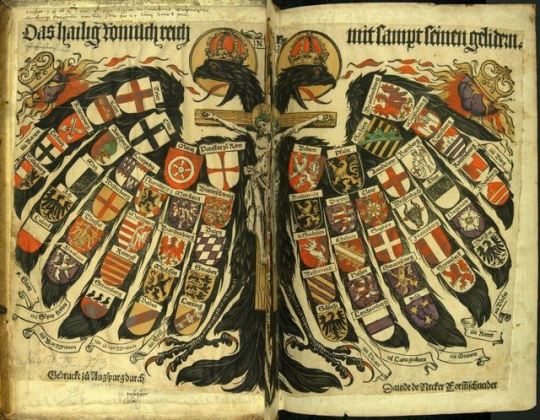





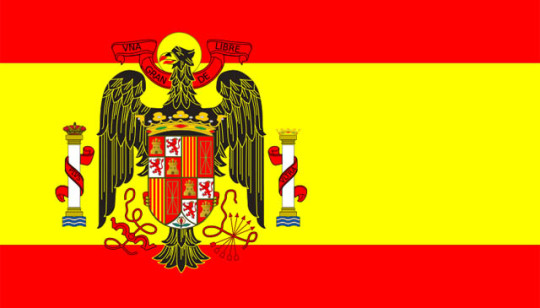



“The earliest depiction of the double-headed eagle can be found on ancient on Hittite monuments in central Anatolia. In the early 19th century, in Boğazkale, an old Hittite capital in modern-day Turkey...The double-headed eagle motif originally dates from c. 3800 BC. The Hittites had worshiped the double headed eagle as the King of Heaven, who was also called the Hittite Bird of the Sun. The bird was their symbol to signify Hittite military power.”

”The bird bird appears in Lygash under the name of Imgig, and was the Sumerian symbol for the god of Lagash, Ninurta son of Enlil...the double-headed eagle, however, is not restricted to supporting deities, and also appears supporting human figures. This is an indication of the use of the eagle as a personal (or family) symbol...The Seliuk Turks referred to it as Hamca and among the Zuni it appeared as a highly conventionalized design, but still as a double-headed thunder bird, the Sikyatki.”
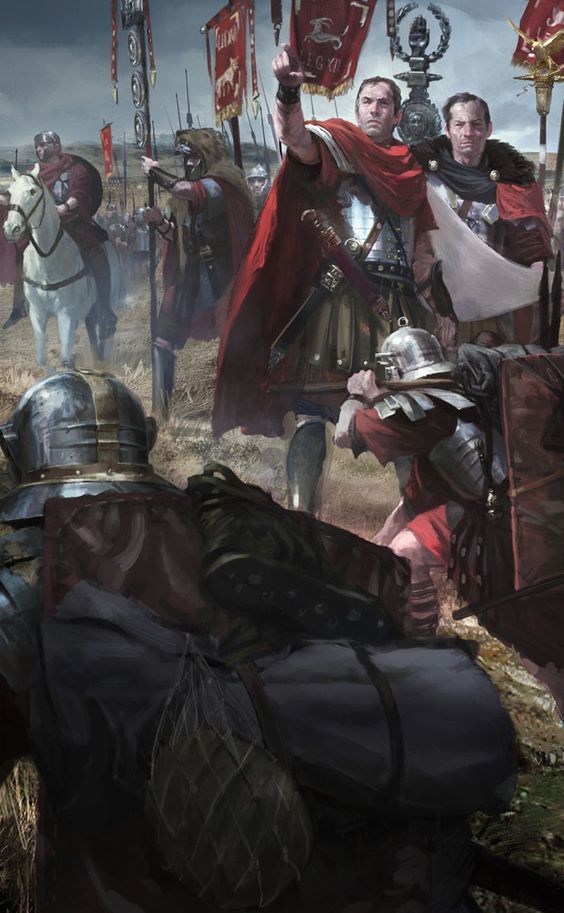
”The double-headed eagle has been used as an emblem by countries, nations, and royal houses in Europe since the early medieval period. Notable examples include the Byzantine House of Palaiologos, the Holy Roman Empire, the House of Habsburg, and the Ruriks and Romanovs of Russia. The symbol often appears on countries’ coats of arms and flags. The emblem was adopted by the Russians, Poles, Serbians, Prussians, Austrians and Saxons. It was used as a private seal and as arms in Germany, Spain, France, Netherlands, England, and Russia.”
(via Mystery Of The Ancient Double-Headed Eagle Symbol | Locklip)
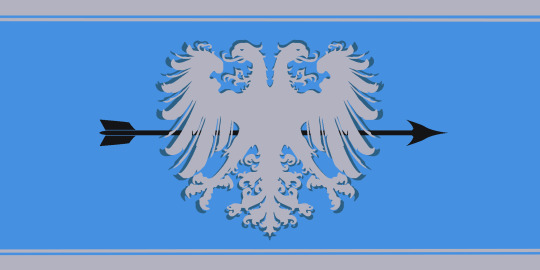
Double Headed Eagle iconology of Byzantium
“Greek scholars have tried to make links with ancient symbols: the eagle was a common design representing power in ancient city-states, while there was an implication of a "dual-eagle" concept...However, there is virtually no doubt that its origin is a blend of Roman and Eastern influences. Indeed, the early Byzantine Empire inherited the Roman eagle (extended wings, head facing right) as an imperial symbol.”

“[T]he church of Greece kept, and is to this date still using Byzantine flags with the eagle, usually black on yellow/gold background. But after the Ottoman conquest this symbol also found its way to a "new Constantinople" (or Third Rome), i.e. Moscow. Russia, deeply influenced by the Byzantine Empire, saw herself as its heir and adopted the double-headed eagle as its imperial symbol. It was also adopted by the Serbs, the Montenegrins, the Albanians and a number of Western rulers, most notably in Germany and Austria.”
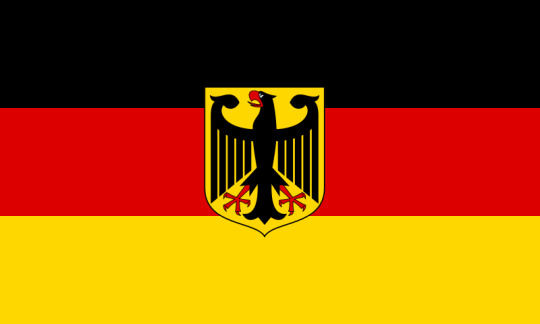
“The first mention of a double-headed eagle in the West dates from 1250 in a roll of arms of Matthew of Paris for Emperor Friedrich II. Theodore II Laskaris chose it for his symbol as Emperor (Empire of Nicaea), taking it to symbolize his state's claims to all the Byzantine Empire's former domains, both European (West) and Asian (East)... After the recapture of Constantinople and the restoration of the Byzantine Empire, the symbol was used as an emblem of the imperial family, but it is uncertain whether it was the official emblem of the Empire.”

“The double-headed eagle became the standard of the Seljuk Turks with the crowning of Toghrül (meaning "Eagle") Beg at Mosul in 1058 as "King of the East and the West" and was much used afterwards. The Sultans of Rum, Ala ad-Din Kay Qubadh I (1220-1237) and his son Kay Khusrau II (1237-1246) used the bicephalous eagle in their standards, and the motif was also found on tissues, cut stones, mural squares, and Koran holders.”
(via Double Headed Eagle iconology of Byzantium | Kythera Family blog)

The double-headed eagle of the Third Rome
“When looking carefully, you can distinguish 9 coats of arms on the eagle. However, in most cases, these shields are printed so tiny that few details can be revealed. The center shield on the eagle's chest is the one with the arms of Moscow. Then, in clockwise order starting from the heads, we see the arms of [Khanate of] Astrakhan, [Khanate of] Siberia, [Kingdoms & Principalities of] Georgia, [Grand Duchy of] Finland, [Grand Principalities of] Kiev-Vladimir-Novgorod, [Khanate of] Taurica, [Kingdom of] Poland and [Khanate of] Kazan...this double-headed eagle represents about 500 years of Russian imperial history.”
(via The double-headed eagle of the Third Rome | Franky’s Scripophily BlogSpot)
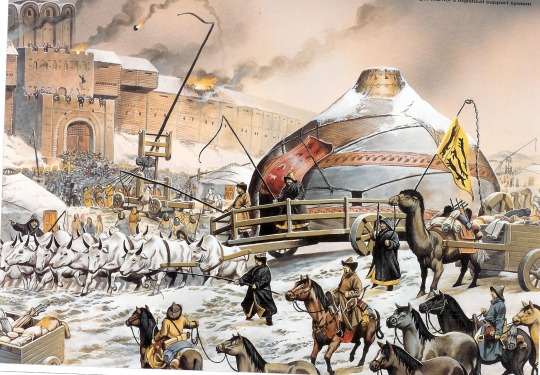
Kiev and the Byzantine Legacy in Russia
“The history of Kiev begins under the rule of the Rus. The Rus (also known as Varangians) were original Vikings who began to trade along the Volga River and later the Dnieper River. They establish several principalities centered on cities like Novgorod and later Kiev...Vladimir was also among the rulers of Kiev who gave military assistance to the Byzantines, leading to the formation of the Varangian Guard...Saint Sophia's Cathedral in Kiev, which dates to the early 11th century. It was designed rival Hagia Sophia in Constantinople, thus symbolizes Kiev as the 'new Constantinople'. There was even a Golden Gate in Kiev, named after the famous Golden Gate of Constantinople. In addition, the Kiev Monastery of the Caves date to 1051 and were influential in the spread of Orthodox thought.“
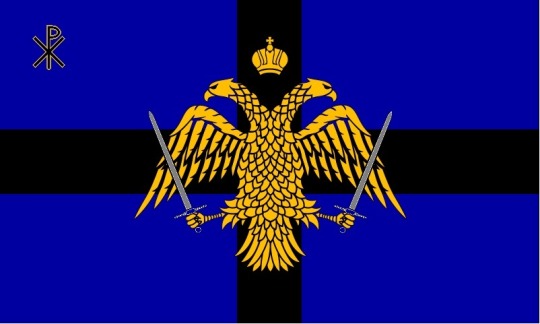
“As the Byzantine Empire was slowly dying, Moscow began to grow in power. The Metropolitan of Kiev moved to Moscow in the 14th century as the Tatars undermined the power of Kiev. Ivan III (1440-1505), the Grand Prince of Moscow, ended the dominance of the Golden Horde in Russia, and became to expand his own power. In 1472, He married Sophia Palaiologina, the niece of the last Byzantine Emperor, after the fall of Constantinople. He would then claim that Moscow was the “Third Rome” and by the end of the 16th century, the Metropolitan of Moscow claimed the title of patriarch. The title Tsar also reflects this claim to be the successor of Constantinople. In fact, the Russian Empire’s symbol was the Byzantine Double Eagle until the Soviet’s overthrew Tsar Nicholas II. This symbol has since returned after the fall of the Soviet Union.“

Mongol-Papal Encounter: Letter Exchange between Pope Innocent IV and Güyük Khan in 1245-1246
“By the late 1230s, Mongol armies had begun raiding parts of Russia and eastern Europe. Between 1236 and 1242, these military campaigns–commanded by Subutai (d. 1248), Batu Khan (d. 1255), and Berke (d. 1266), among others–had wrought major devastation across Russia, Poland, Hungary and the Balkans. The cities of Kiev, Pereyaslavl, Chernihiv, Lublin, and other major population centers in eastern and central Europe were sacked and their populations massacred.”
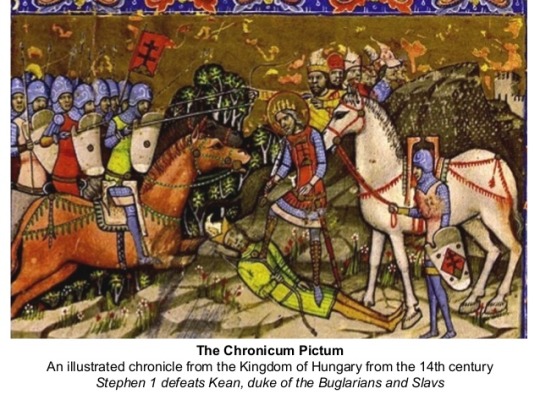
“The defeats of the Polish forces at the Battle of Liegnitz/Legnica (April 9th 1241) and the Hungarian military at the Battle of Mohi (April 11th 1241) opened up most of the Balkans and Central Europe to Mongol raids, leading to even more destruction, displacement and massacres. These alarming developments shook the foundations of Latin Christendom. Although the Mongols withdrew from most of the Balkans and east-central Europe soon after”
(via Mongol-Papal Encounter: Letter Exchange between Pope Innocent IV and Güyük Khan in 1245-1246 | Ballandalus blog)
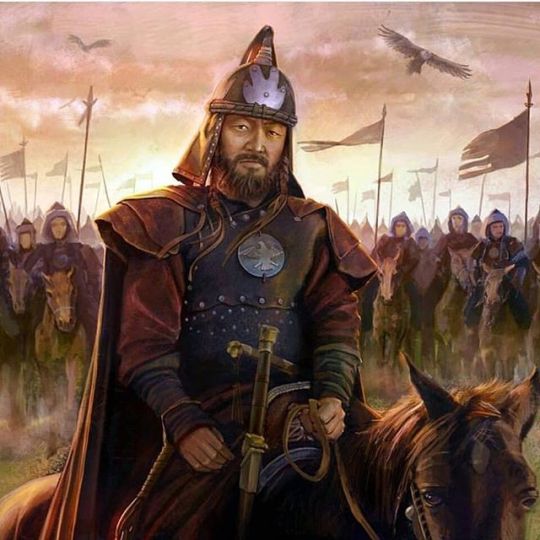
Borjigin
“A Borjigin or Borjigid is a member of the sub-clan, which started with Yesugei (but the Secret History of the Mongols makes it go back to Yesugei's ancestor Bodonchar), of the Kiyat clan. Yesugei's descendants were thus said to be Kiyat-Borjigin. The senior Borjigid provided ruling princes for Mongolia and Inner Mongolia until the 20th century. The clan formed the ruling class among the Mongols and some other peoples of Central Asia and Eastern Europe.”
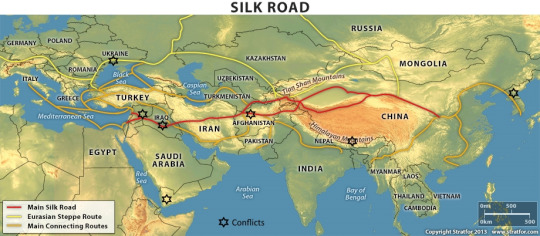
“The Borjigin family ruled over the Mongol Empire from the 13th to 14th century. The rise of Genghis (Chingis) narrowed the scope of the Borjigid-Kiyad clans sharply. This separation was emphasized by the intermarriage of Genghis's descendants with the Barlas, Baarin, Manghud and other branches of the original Borjigid.”

”In the western regions of the Empire, the Jurkin and perhaps other lineages near to Genghis's lineage used the clan name Kiyad but did not share in the privileges of the Genghisids. The Borjigit clan had once dominated large lands stretching from Java to Iran and from Indo-China to Novgorod. In 1335, with the disintegration of the Ilkhanate in Iran, the first of numerous non-Borjigid-Kiyad dynasties appeared. Established by marriage partners of Genghisids, these included the Suldus Chupanids, Jalayirids in the Middle East, the Barulas dynasties in Chagatai Khanate and India, the Manghud and Onggirat dynasties in the Golden Horde and Central Asia, and the Oirats in western Mongolia.In 1368, under Toghun Temür, the Yuan dynasty was overthrown by the Ming dynasty in China but members of the family continued to rule over Mongolia homeland into the 17th century, known as the Northern Yuan dynasty.”
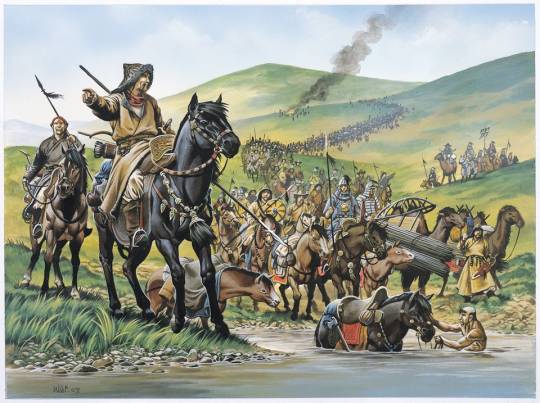
“After the breakup of the Golden Horde, the Khiyat continued to rule the Crimea and Kazan until the late 18th century. They were annexed by the Russian Empire and the Chinese...The Qing dynasty respected the Borjigin family and the early emperors married the Hasarid Borjigids of the Khorchin. Even among the pro-Qing Mongols, traces of the alternative tradition survived. Aci Lomi, a banner general, wrote his History of the Borjigid Clan in 1732–35. The 18th century and 19th century Qing nobility was adorned by the descendants of the early Mongol adherents including the Borjigin.”

“Genghis Khan founded the Mongol Empire in 1206. His grandson, Kublai Khan, after defeating his younger brother Ariq Böke, founded the Yuan dynasty in China in 1271. The dynasty was overthrown by the Ming dynasty during the reign of Toghaghan-Temür in 1368, but it survived in Mongolia homeland, known as the Northern Yuan dynasty.”

Bahri dynasty
“The Bahri dynasty or Bahriyya Mamluks was a Mamluk dynasty of mostly Cuman-Kipchak Turkic origin that ruled the Egyptian Mamluk Sultanate from 1250 to 1382. They followed the Ayyubid dynasty, and were succeeded by a second Mamluk dynasty, the Burji dynasty."
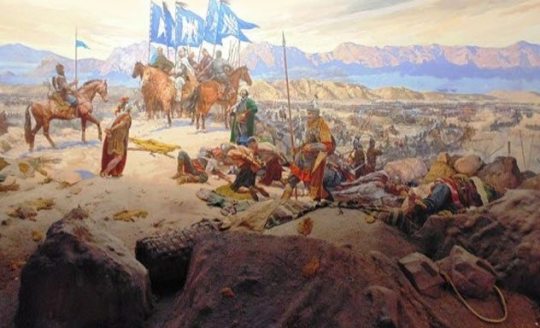

Burji dynasty
“From 1250 Egypt had been ruled by the first Mamluk dynasty, the mostly Cuman-Kipchak Turkic Bahri dynasty. In 1377 a revolt broke out in Syria which spread to Egypt...Barquq was proclaimed sultan in 1382, ending the Bahri dynasty...Permanently in power, he founded the Burji dynasty.”
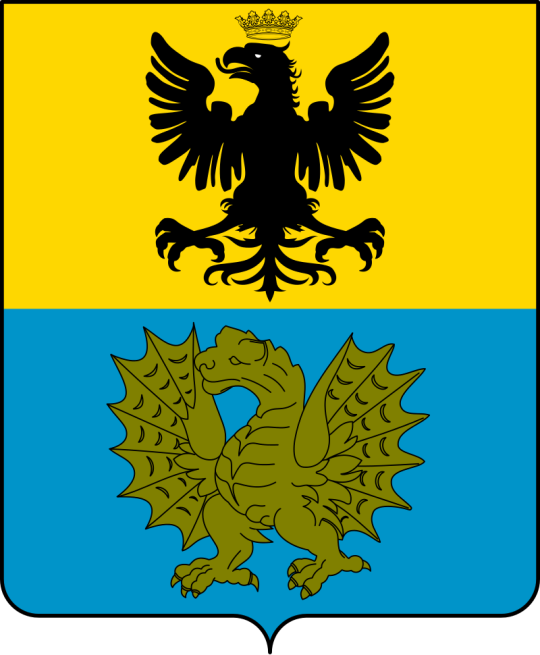
House of Borghese
“Borghese is the surname of a princely family of Italian noble and papal background, originating as the Borghese or Borghesi in Siena, where they came to prominence in the 13th century holding offices under the commune. The head of the family, Marcantonio, moved to Rome in the 16th century and there, following the election (1605) of his son Camillo as Pope Paul V they rose in power and wealth. They were one of the leading families of the Black Nobilityand maintain close ties to the Vatican.”

Guelphs and Ghibellines
“The Guelphs and Ghibellines were factions supporting the Pope and the Holy Roman Emperor, respectively, in the Italian city-states of central and northern Italy. During the 12th and 13th centuries, rivalry between these two parties formed a particularly important aspect of the internal politics of medieval Italy.”
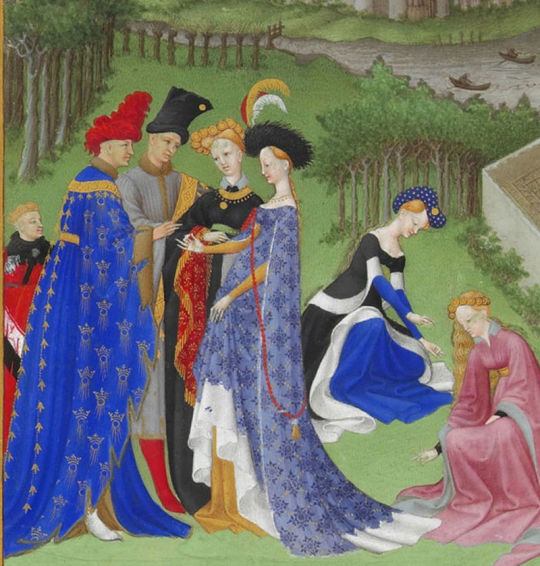
”The names were likely introduced to Italy during the reign of Frederick Barbarossa. When Frederick conducted military campaigns in Italy to expand imperial power there, his supporters became known as Ghibellines (Ghibellini). The Lombard League and its allies were defending the liberties of the urban communes against the Emperor's encroachments and became known as Guelphs (Guelfi). The Ghibellines were thus the imperial party, while the Guelphs supported the Pope. Broadly speaking, Guelphs tended to come from wealthy mercantile families, whereas Ghibellines were predominantly those whose wealth was based on agricultural estates.”
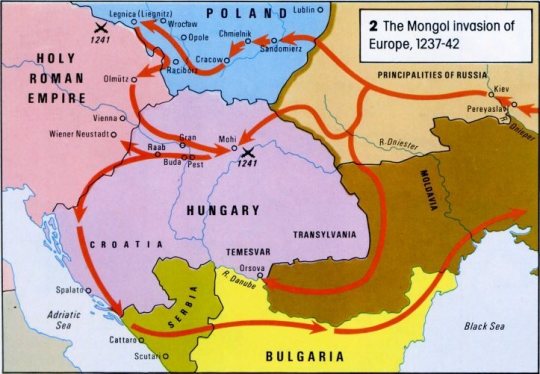
Frederick II, Holy Roman Emperor
“In 1241–1242, the forces of the Golden Horde decisively defeated the armies of Hungary and Poland and devastated their countryside and all their unfortified settlements. King Béla IV of Hungary appealed to Frederick for aid, but Frederick, being in dispute with the Hungarian king for some time (as Bela had sided with the Papacy against him) and not wanting to commit to a major military expedition so readily, refused. He was unwilling to cross into Hungary, and although he went about unifying his magnates and other monarchs to potentially face a Mongol invasion, he specifically took his vow for the defense of the empire on "this side of the Alps."

”Frederick was aware of the danger the Mongols posed, and grimly assessed the situation, but also tried to use it as leverage over the Papacy to frame himself as the protector of Christendom. While he called them traitorous pagans, Frederick expressed an admiration for Mongol military prowess after hearing of their deeds, in particular their able commanders and fierce discipline and obedience, judging the latter to be the greatest source of their success. He called a levy throughout Germany while the Mongols were busy raiding Hungary. In mid 1241 Federick dispersed his army back to their holdfasts as the Mongols preoccupied themselves with the lands east of the Danube, attempting to smash all Hungarian resistance. He subsequently ordered his vassals to strengthen their defenses, adopt a defensive posture...A chronicler reports that Frederick received a demand of submission from Batu Khan at some time.”
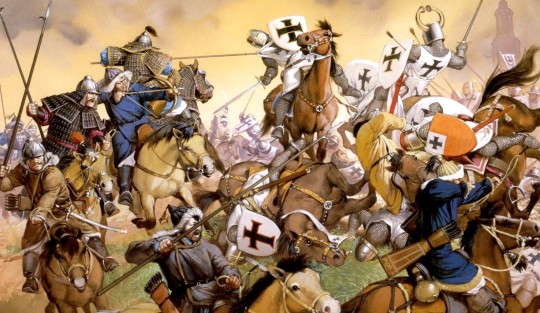
“A letter written by Emperor Frederick II, found in the Regesta Imperii, dated to June 20, 1241, and intended for all his vassals in Swabia, Austria, and Bohemia, included a number of specific military instructions. His forces were to avoid engaging the Mongols in field battles, hoard all food stocks in every fortress and stronghold, and arm all possible levies as well as the general populace.
Mongol probing attacks materialised on the Holy Roman Empire's border states...A full-scale invasion never occurred, as the Mongols spent the next year pillaging Hungary before withdrawing. After the Mongols withdrew from Hungary back to Russia, Frederick turned his attention back towards Italian matters.”

Pope Innocent IV
“In 1245, Innocent IV issued bulls and sent an envoy in the person of Giovanni da Pian del Carpine (accompanied by Benedict the Pole) to the "Emperor of the Tartars". The message asked the Mongol ruler to become a Christian and stop his aggression against Europe. The Khan Güyük replied in 1246 in a letter written in Persian that is still preserved in the Vatican Library, demanding the submission of the Pope and the other rulers of Europe...two Mongolian envoys to the Papal seat in Lyon, Aïbeg and Serkis. In the letter Guyuk demanded that the Pope appear in person at the Mongol imperial headquarters, Karakorum in order that “we might cause him to hear every command that there is of the jasaq”.

Seventh Crusade
“In 1244, the Khwarezmians, recently displaced by the advance of the Mongols, took Jerusalem on their way to ally with the Egyptian Mamluks. This returned Jerusalem to Muslim control, but the fall of Jerusalem was no longer a crucial event to European Christians, who had seen the city pass from Christian to Muslim control numerous times in the past two centuries. This time, despite calls from the Pope, there was no popular enthusiasm for a new crusade. There were also many conflicts within Europe that kept its leaders from embarking on the Crusade.”
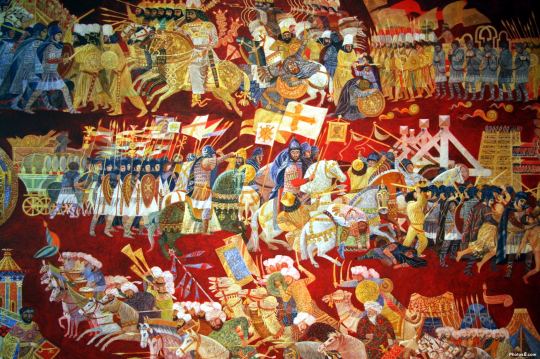
“Pope Innocent IV and Frederick II, Holy Roman Emperor continued the papal-imperial struggle. Frederick had captured and imprisoned clerics on their way to the First Council of Lyon, and in 1245 he was formally deposed by Innocent IV. Pope Gregory IX had also earlier offered King Louis' brother, count Robert of Artois, the German throne, but Louis had refused. Thus, the Holy Roman Emperor was in no position to crusade. Béla IV of Hungary was rebuilding his kingdom from the ashes after the devastating Mongol invasion of 1241.”
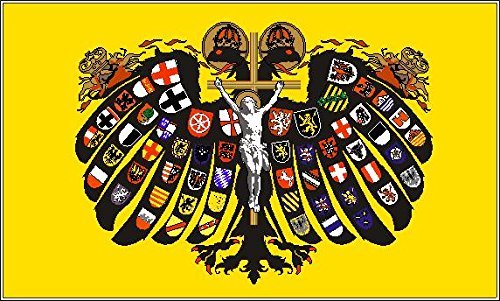
Interregnum (Holy Roman Empire)
“The term Great Interregnum is occasionally used for the period between 1250 (death of Frederick II) and 1273 (accession of Rudolf I)...After the deposition of Frederick II by Pope Innocent IV in 1245...in 1273, Rudolf I of Germany, a minor pro-Staufen count, was elected. He was the first of the Habsburgs to hold a royal title, but he was never crowned emperor. After Rudolf's death in 1291, Adolf and Albert were two further weak kings who were never crowned emperor...Sigismund (r. 1411 – 1437) was crowned emperor in 1433, but only with Frederick III (r. 1452 – 1493), the second emperor of the House of Habsburg, did the Holy Roman Emperor return to an unbroken succession of emperors (with the exception of Charles VII all of the House of Habsburg) until its dissolution in 1806.”

Franco-Mongol alliance
“European attitudes began to change in the mid-1260s, from perceiving the Mongols as enemies to be feared, to potential allies against the Muslims. The Mongols sought to capitalize on this, promising a re-conquered Jerusalem to the Europeans in return for cooperation. Attempts to cement an alliance continued through negotiations with many leaders of the Mongol Ilkhanate in Persia, from its founder Hulagu through his descendants Abaqa, Arghun, Ghazan, and Öljaitü, but without success. The Mongols invaded Syria several times between 1281 and 1312, sometimes in attempts at joint operations with the Franks, but the considerable logistical difficulties involved meant that forces would arrive months apart, never able to coordinate activities in any effective way...the Egyptian Mamluks successfully recaptured all of Palestine and Syria from the Crusaders.”

“Christian kings began to prepare for a new crusade (the Seventh Crusade), declared by Pope Innocent IV in June 1245 at the First Council of Lyon. The loss of Jerusalem caused some Europeans to look to the Mongols as potential allies of Christendom, provided the Mongols could be converted to Western Christianity. In March 1245, Pope Innocent IV had issued multiple papal bulls, some of which were sent with an envoy, the Franciscan John of Plano Carpini, to the "Emperor of the Tartars". In a letter now called the Cum non solum, Pope Innocent expressed a desire for peace, and asked the Mongol ruler to become a Christian and to stop killing Christians. However, the new Mongol Great Khan Güyük, installed at Karakorum in 1246, replied only with a demand for the submission of the pope, and a visit from the rulers of the West in homage to Mongol power:”

Hohenstaufen
“The Hohenstaufen also known as Staufer, were a dynasty of German kings (1138–1254) during the Middle Ages. Before ascending to the kingship, they were Dukes of Swabia from 1079. As kings of Germany, they had a claim to Italy, Burgundy and the Holy Roman Empire. Three members of the dynasty—Frederick I (1155), Henry VI (1191) and Frederick II (1220)—were crowned emperor. Besides Germany, they also ruled the Kingdom of Sicily (1194–1268) and the Kingdom of Jerusalem (1225–1268) [succeeded by the House of Habsburg in 1268]”
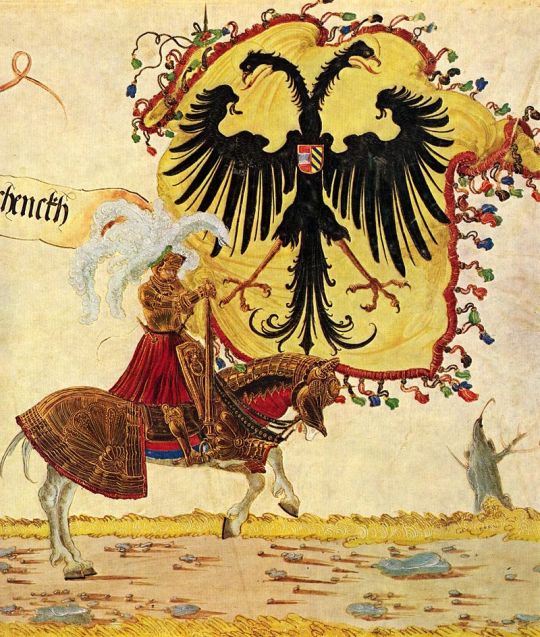
House of Habsburg
“The House of Habsburg and alternatively called the House of Austria was one of the most influential and distinguished royal houses of Europe. The throne of the Holy Roman Empire was continuously occupied by the Habsburgs from 1438 until their extinction in the male line in 1740. The house also produced emperors and kings of Bohemia, Hungary, Croatia, Galicia, Portugal and Spain with their respective colonies, as well as rulers of several principalities in the Netherlands and Italy.”

“The Habsburg Empire was never composed of a single unified and unitary state as Bourbon France, Hohenzollern Germany, or Great Britain was. It was made up of an accretion of territories that owed their historic loyalty to the head of the house of Habsburg as hereditary lord. The Habsburgs had mostly married the heiresses of these territories, most famously of Spain and the Netherlands. They used their coats of arms then as a statement of their right to rule all these territories."
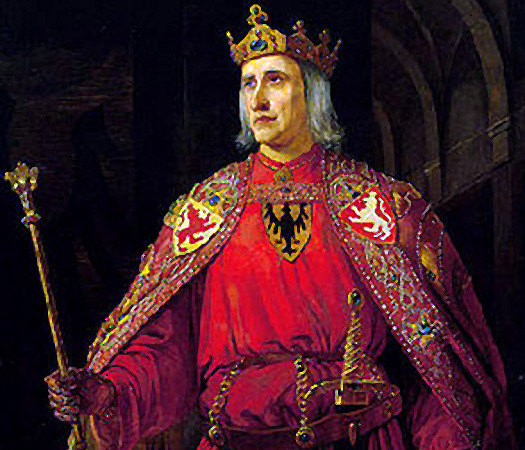
Rudolf I of Germany
“Rudolf I, also known as Rudolf of Habsburg was Count of Habsburg from about 1240 and King of Germany from 1273 until his death.Rudolf's election marked the end of the Great Interregnum in the Holy Roman Empire after the death of the Hohenstaufen emperor Frederick II in 1250.
The disorder in Germany during the interregnum after the fall of the Hohenstaufen dynasty afforded an opportunity for Count Rudolf to increase his possessions. His wife was a Hohenberg heiress; and on the death of his childless maternal uncle Count Hartmann IV of Kyburg in 1264, he also seized his valuable estates.”

Kyburg family
“Kyburg also Kiburg was a noble family of grafen (counts) in the Duchy of Swabia, a cadet line of the counts of Dillingen, who in the late 12th and early 13th century ruled the County of Kyburg, corresponding to much of what is now Northeastern Switzerland.The family was one of the four most powerful noble families in the Swiss plateau beside the House of Habsburg, House of Zähringen and the House of Savoy during 12th century. With the extinction of the Kyburg family's male line in 1264, Rudolph of Habsburg laid claim to the Kyburg lands and annexed them to the Habsburg holdings, establishing the line of "Neu-Kyburg", which was in turn extinct in 1417.”
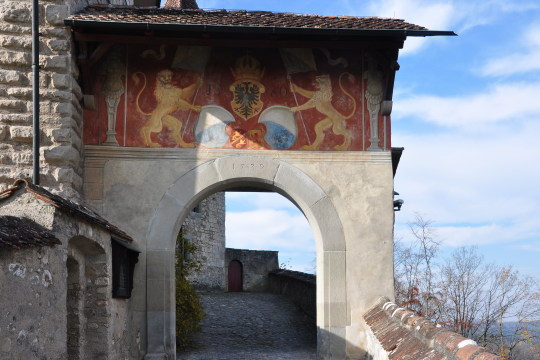
“In 1250/51 the childless Hartmann IV gave the western part of the property with the center of Burgdorf to his nephew Hartmann V. As a result, Hartmann V, who was supported by the Habsburgs, came into conflict repeatedly with the growing city-state of Bern. His uncle had to step in often to keep the peace. When Hartmann V died in 1263, Count Rudolf von Habsburg became the guardian of Hartmann's daughter Anna, and also took over the administration of the western section. In 1264, after the death of Hartman IV, Rudolf stepped in to control the eastern half as well. Though this brought him into conflict with the claims by the widow Margaret of Savoy and her family.”

”Anna, daughter of Hartmann V, married Eberhard I of Habsburg-Laufenburg. This marriage was intended to secure Habsburg interests in Aargau (Argovia) against Savoy. The son of Eberhard and Anna, Hartmann I (1275–1301) again called himself "of Kyburg". His line came to be known as that of Neu-Kyburg or Kyburg-Burgdorf, persisting until 1417.”

House of Borgia
“The House of Borgia was an Italo-Spanish noble family, which rose to prominence during the Italian Renaissance. They were from Aragon, the surname being a toponymic from the town of Borja, then in the Crown of Aragon, in Spain.The Borgias became prominent in ecclesiastical and political affairs in the 15th and 16th centuries, producing two popes: Alfons de Borja, who ruled as Pope Callixtus III during 1455–1458, and Rodrigo Lanzol Borgia, as Pope Alexander VI, during 1492–1503.”

Name of Turkey
“The English name Turkey, now applied to the modern Republic of Turkey, is historically derived (via Old French Turquie) from the Medieval Latin Turchia, Turquia. It is first recorded in Middle English (as Turkye, Torke, later Turkie, Turky), attested in Chaucer, ca. 1369. The Ottoman Empire was commonly referred to as Turkey or the Turkish Empire
The English name of Turkey (from Medieval Latin Turchia/Turquia) means "land of the Turks"...The phrase land of Torke is used in the 15th-century Digby Mysteries. Later usages can be found in the Dunbar poems, the 16th century Manipulus Vocabulorum ("Turkie, Tartaria")...The medieval Greek and Latin terms did not designate the same geographic area now known as Turkey. Instead, they were mostly synonymous with Tartary, a term including Khazaria and the other khaganates of the Central Asian steppe, until the appearance of the Seljuks and the rise of the Ottoman Empire in the 14th century...The Arabic cognate Turkiyya (Arabic: تركيا) in the form Dawla al-Turkiyya (State of the Turks) was historically used as an official name for the medieval Mamluk Sultanate which covered Egypt, Palestine, Syria, Hejaz and Cyrenaica.”

What’s the Word for Turkey in Turkish?
“The word for turkey in Turkish is hindi.What? OK, so what’s the Hindi word for turkey?Turns out that the word for turkey in Hindi is टर्की. And that, if you don’t know Devanagari, is transcribed ṭarkī in the Latin alphabet.
Turkeys are native to the Americas, but the Europeans first encountering them thought that they looked like a kind of guinea fowl, another large, ungainly, colorful-faced kind of bird. Now, guinea fowl were also called turkey fowl, but that’s because they actually had a legitimate connection to Turkey the country: Europeans received most of their guinea fowl imported via Turkey...the first turkeys brought to Europe also generally came via Turkey: The birds had originally been domesticated by the Aztecs and were brought to Europe by Spanish conquistadores, who traded them to the rest of the continent via North Africa.
Japanese and Korean call it the equivalent of “seven-faced bird,” Abkhazian and other languages in the Caucasus call it “blue bird,” and Thai and Urdu call it “elephant chicken” or “elephant trunk chicken.” ��
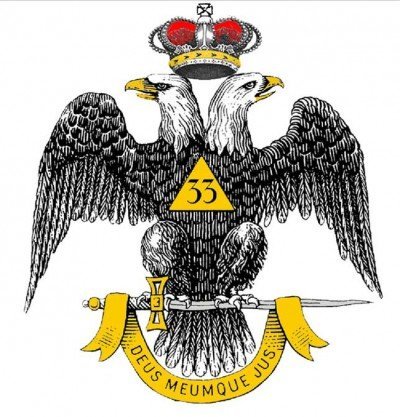
(via What’s the Word for Turkey in Turkish? | Slate)
#turkey#silkroad#chainofcommerce#noblemerchantclans#ambasadorsorspies#kiyat#borjigin#burji#borgia#borghese#kiburg#ghibelines#holyromanempire#rudolfofhapsburg#hapsburgdynasty#vladtheimpaler#transylvania#house of saxe-coburg and gotha#popeinnocentiv#guyukkhan#mongolultimatum#marriagealliance#tributetax#wagewarfortribute#secrethistoryofthemongols#doubleheadedeagle#goldenhorde#goldenorder
14 notes
·
View notes
Photo
Unbelievably fantastic illustration -- just WOW! Definitely go check this out!
And if you like stories of this type, you might also enjoy The Mongoliad, which is about a band of folks (including, yes, a samurai) who -- after the Battle of Legnica -- set off on a journey to kill Kublai Khan. It’s a collaboration of stellar writing from a bunch of people, including Neal Stephenson (whose dialog, IMO, fairly leaps off the page, it’s so clear when it’s him who is writing).
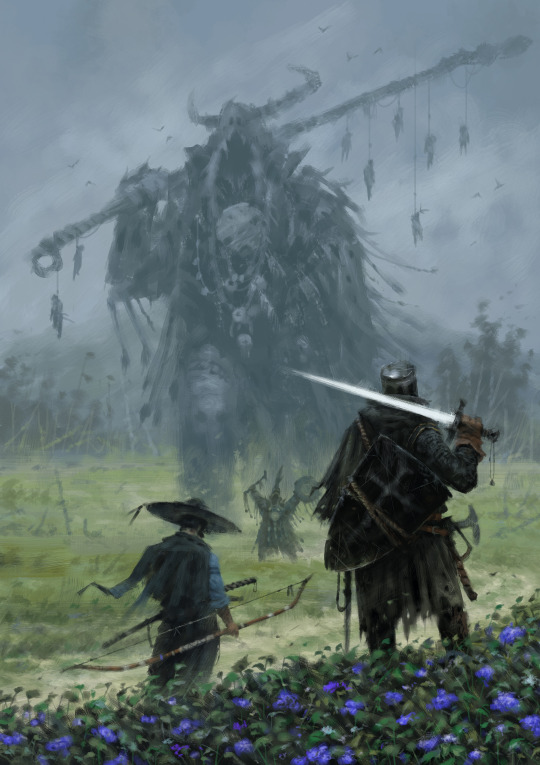
‘Brothers in arms - Shaman’ “What do you mean it was your last arrow?“ Continuation and another part of the story from the ‘Brothers in arms’ series. Stories about William, a young hospital knight who lost his faith, disappointed with the crusades, and at the end of the 13th century, with a merchant caravan set off to Asia. After years of travel and extraordinary adventures, ended up in Japan, where he became a friend of a Samurai named Sukesada.Together they faced the Mongol invasion and had many extraordinary adventures. William wrote down his adventures in his personal journal. It is hard to say what of the stories he describes is true and what is just colored fiction. The reason for that is the fact that William had a tendency to exaggerate and very fanciful descriptions of his adventures. "The young girl who begged us for help came from a nearby village tormented by a sadistic Shaman. She told us stories about some dark rituals and demons. Without thinking we set out to help these poor people. The road to the village was marked by a line of trees, on which massacred people hung. There was a strange smell of sulfur in the air, it was quiet, unnaturally quiet. I saw focus and tension on my companion’s face, but no fear. And then, I saw him, screaming, hitting the drum, in a mad dance, like he was casting some dark spell. Suddenly, the tree behind him turned into a huge, demonic monster. The monster appeared to be some sort of a demonic servant and guardian of this Shaman. This task turned out to be much more difficult than I initially assumed” Work process: https://www.artstation.com/artwork/Xnqe8n
2K notes
·
View notes
Note
I was reading your old post about the Mongols in Europe, and I think you'd underestimate Mongols in Europe. Yes, Europe is far from the steppe, but so is Iran or South China. Europeans have castles, but Mongols won sieges: Alamut, Xiangyang, Kiev, Baghdad. Your proposed strategy for W. Europe sounds historically like the strategy tried by Georgia/Armenia, but both became Mongol vassals. Western Europe might not be worth invasion, but if the Mongols were to invade, why would they be stopped?
I don’t think so, Anon. Mongols, along with katanas and longships, often have their capabilities overestimated by a significant margin. Certainly, I get the appeal, it’s a hard sell to say that the forces that created the most significant contiguous land empire in the world are overrated, but the evidence supports that the Mongols could not have conquered all the way through Europe. The Mongol way of warfare was very strong in certain situations, but there were significant detriments which commanders picked up on very quickly after seeing the Mongols in action.
The Mongols did win sieges, but they also fared very poorly against European stone castles. While they were able to handle wooden and earthen castles very easily, during the first Mongol invasion of Hungary, stone castles were formidable redoubts and none were taken despite several being deep in Mongol-controlled territory. During their assault on Klis Fortress in Croatia, the Mongols were repulsed with heavy casualties. Similarly, the Mongol attempt to take the citadel of Esztergom, despite having an overwhelming numerical advantage and no less than thirty siege engines, ended in failure. The significant number of stone castles would be far harder for Mongols to crack open than the Khwarezmid Empire, which typically used earth, clay, and wood for their defenses.
While Mongols were tremendously effective against light infantry and light cavalry, they fared very poorly against heavy cavalry and heavy infantry. Even in their commanding victories at Mohi and Legnica, the Mongols faced significant trouble when fielded against the heavy forces of the Knights Templar, the latter battle had only 3 knights die. Moving to denser, richer territories would mean facing more of these powerful units.
The Black Forest would have been difficult to forage in, the German principalities had much denser populations, and the Mongols were on the brink of civil war in 1241. Simply put, Western Europe was never in any real danger of being conquered by the Mongols.
Thanks for the question, Anon.
SomethingLikeALawyer, Hand of the King
156 notes
·
View notes
Photo
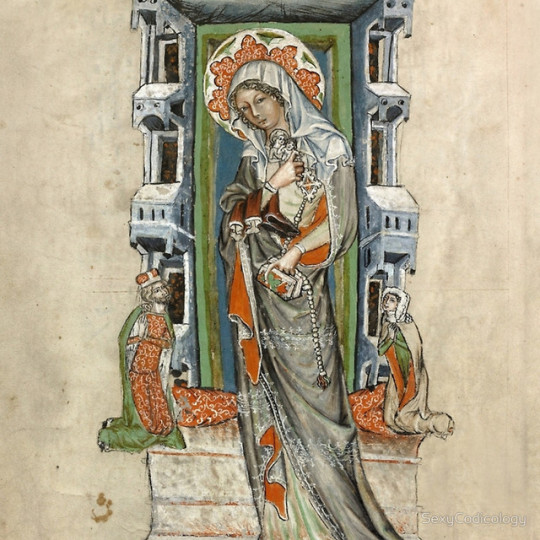
Saint Hedwig of Silesia - Feast Day: October 16th - Both Calendars
Patron of Orphaned Children
Life
The daughter of Duke Berthold IV of Merania and his second wife Agnes of Wettin, was born at Andechs Castle in the Duchy of Bavaria. Her elder sister Agnes married King Philip II of France (annulled in 1200), her sister Gertrude (killed in 1213) King Andrew II of Hungary, while the youngest Matilda (Mechtild) became abbess at the Benedictine convent of Kitzingen in Franconia, where Hedwig also received her education. By her sister Gertrude, she was the aunt of Saint Elizabeth of Hungary.
Duchess Consort
At the age of twelve, Hedwig married Henry I the Bearded, son and heir of the Piast duke Boleslaw I the Tall of Silesia. As soon as Henry succeeded his father in 1201, he had to struggle with his Piast relatives, at first with his uncle Duke Mieszko IV Tanglefoot who immediately seized the Upper Silesian Duchy of Opole. In 1206 Henry and his cousin Duke Wladyslaw III Spindleshanks of Greater Poland agreed to swap the Silesian Lubusz Land against the Kalisz region, which met with fierce protest by Wladyslaw’s III nephew Wladyslaw Odonic. When Henry went to Gasawa in 1227 to meet his Piast cousins, he narrowly saved his life, while High Duke Leszek I the White was killed by the men of the Pomerelian Duke Swietopelk II, instigated by Wladyslaw Odonic.
The next year Henry’s ally Wladyslaw III Spindleshanks succeeded Leszek I as High Duke; however as he was still contested by his nephew in Greater Poland, he made Henry his governor at Krakow, whereby the Silesian duke once again became entangled into the dispute over the Seniorate Province. In 1229 he was captured and arrested at Plock Castle by rivaling Duke Konrad I of Masovia. Hedwig proceeded to Plock pleading for Henry and was able to have him released.
Her actions promoted the reign of her husband: Upon the death of the Polish High Duke Wladyslaw III Spindleshanks in 1231, Henry also became Duke of Greater Poland and the next year prevailed as High Duke at Krakow. He thereby was the first of the Silesian Piast descendants of Wladyslaw II the Exile to gain the rule over Silesia and the Seniorate Province according to the 1138 Testament of Boleslaw III Krzywousty.
Widow
In 1238, upon his death, Henry was buried at the Cistercian convent of Trzebnica Abbey (Kloster Trebnitz), which he had established in 1202 at Hedwig’s request. The widow moved into the convent, which was led by her daughter Gertrude. She invited numerous German religious from the Holy Roman Empire into the Silesian lands, as well as German settlers who founded numerous cities, towns and villages in the course of the Ostsiedlung, while cultivating barren parts of Silesia for agriculture.
Hedwig and Henry had several daughters, though only one surviving son, Henry II the Piou, who succeeded his father as Duke of Silesia and Polish High Duke. The widow however had to witness the killing of her son, vainly awaiting the support of Emperor Frederick II, during the Mongol invasion of Poland at the Battle of Legnica (Wahlstatt) in 1241. The hopes for a re-united Poland were lost and even Silesia fragmented into numerous Piast duchies under Henry’s II sons. Hedwig and her daughter-in-law, Henry’s II widow Anna of Bohemia, establidshed a Benedictine abbey at the site of the battle in Legnickie Pole, settled with monks descending from Opatovice in Bobhemia.
Hedwig and Henry had lived a very pious life, and Hedwig had great zeal for religion. She had supported her husband in donating the Augustinian provostry at Nowogrod Bobrzanski (Naumburg) and the commandry of the Knights Templar at Olesnica Mala (Klein Oels). Hedwig always helped the poor and donated all her fortune to the Church. According to legend, she went barefoot even in winter, and when she was urged by the Bishop of Wroclaw to wear shoes, she took them in her hands. On 15 October 1243, Hedwig died and was buried in Trzebnica, while relics of her are preserved at Andechs Abbey and St. Hedwig’s Cathedral in Berlin.
Veneration
Hedwig was canonized in 1267 by Pope Clement IV, a supporter of the Cistercian order, at the suggestion of her grandson Prince-Archbishop Wladylaw of Salzburg. She is the patron saint of Silesia, of Andechs, and of the Roman Catholic Archdiocese of Wroclaw and the Roman Catholic Diocese of Gorlitz. Her feast day according to the General Roman Calendar is on October, 16. A 17th century legend has it, that Hedwig on a pilgrimage to Rome stopped at Zell in Austria, where she had healing waters spring up at a source which up to today bears her name.
In 1773 King Frederick II of Prussia, having conquered and annexed Silesia in 1742, had St. Hedwig’s Cathedral in Berlin built for the Catholic Upper Silesian immigrants, now the mother church of the Roman Catholic Archdiocese of Berlin.
Children
Hedwig and Henry I had seven children:
1. Agnes (ca. 1190 — before 11 May 1214).
2. Boleslaw (ca. 1191 — 10 September 1206/08).
3. Henry II the Pious (ca. 1198 — killed in Battle of Legnica, 9 April 1241)
4. Konrad the Curly (ca. 1198 — Czerwony Kosciol, 4 September 1213).
5. Sophie (ca. 1200 — before 22/23 March 1214).
6. Gertrude (ca. 1200 — Trebnitz, 6/30 December 1268), Abbess of Trebnitz
7. A son [Wladyslaw?] (before 25 December 1208 — 1214/17).
4 notes
·
View notes
Photo
There is a city in Poland located in Lower Silesia, called Legnica. Famous for the battle with the Mongols from 1241, it had an interesting nickname between 1945 and 1993 (the year the Red Army finally left Poland).
It was called “Mała Moskwa” (eng. “Little Moscow”), for being the headquarters of the Northern Group of Forces of the Red Army and the largest concentration of Russian troops outside of the USSR. If the Cold War had ever escalated into WW3, the western Soviet armies would have been commanded from there. It would have been also one of the places most likely to get nuked in Poland.
“Little Moscow” consisted of 1/3 of Legnica. It was a city within a city, cordoned from the outside. Any Pole found in one of the Soviet districts without a permit faced prison or death; and over the years approximately 600 Polish citizens died in crimes or accidents for which the Soviet soldiers were responsible.
One of the “best” examples of Soviet Imperialism in Poland.

1K notes
·
View notes
Text
Events 8.26 (before 1900)
683 – Yazid I's army kills 11,000 people of Medina including notable Sahabas in Battle of al-Harrah. 1071 – The Seljuq Turks defeat the Byzantine army at the Battle of Manzikert, and soon gain control of most of Anatolia. 1278 – Ladislaus IV of Hungary and Rudolf I of Germany defeat Ottokar II of Bohemia in the Battle on the Marchfeld near Dürnkrut in (then) Moravia. 1303 – Chittorgarh falls to the Delhi Sultanate. 1346 – At the Battle of Crécy, an English army easily defeats a French one twice its size. 1444 – Battle of St. Jakob an der Birs: A vastly outnumbered force of Swiss Confederates is defeated by the Dauphin Louis (future Louis XI of France) and his army of 'Armagnacs' near Basel. 1542 – Francisco de Orellana crosses South America from Guayaquil on the Pacific coast to the mouth of the Amazon River on the Atlantic coast. 1642 – Dutch–Portuguese War: Second Battle of San Salvador: The Dutch force the Spanish garrison at San Salvador (modern day Keelung, Taiwan) to surrender, ending the short-lived Spanish colony on Formosa and replacing it with a new Dutch administration. 1648 – The Fronde: First Fronde: In the wake of the successful Battle of Lens, Cardinal Mazarin, Chief Minister of France, suddenly orders the arrest of the leaders of the Parlement of Paris, provoking the rest of Paris to break into insurrection and barricade the streets the next day. 1748 – The first Lutheran denomination in North America, the Pennsylvania Ministerium, is founded in Philadelphia. 1767 – Jesuits all over Chile are arrested as the Spanish Empire suppresses the Society of Jesus. 1768 – Captain James Cook sets sail from England on board HMS Endeavour. 1778 – The first recorded ascent of Triglav, the highest mountain in Slovenia. 1789 – The Declaration of the Rights of Man and of the Citizen is approved by the National Constituent Assembly of France. 1791 – John Fitch is granted a United States patent for the steamboat. 1810 – The former viceroy Santiago de Liniers of the Viceroyalty of the Río de la Plata is executed after the defeat of his counter-revolution. 1813 – War of the Sixth Coalition: An impromptu battle takes place when French and Prussian-Russian forces accidentally run into each other near Liegnitz, Prussia (now Legnica, Poland). 1814 – Chilean War of Independence: Infighting between the rebel forces of José Miguel Carrera and Bernardo O'Higgins erupts in the Battle of Las Tres Acequias. 1833 – The great 1833 Kathmandu–Bihar earthquake causes major damage in Nepal, northern India and Tibet, a total of 500 people perish. 1849 – President Faustin Soulouque of the First Republic of Haiti has the Senate and Chamber of Deputies proclaim him the Emperor of Haiti, abolishing the Republic and inaugurating the Second Empire of Haiti. 1863 – The Swedish-language liberal newspaper Helsingfors Dagblad proposed the current blue-and-white cross flag as the flag of Finland. 1883 – The 1883 eruption of Krakatoa begins its final, paroxysmal, stage.
0 notes
Text
Episode 0: My Conquest Is the Sea of Stars

Welcome to the inaugural post of Icebergs, the English-speaking internet’s best website devoted to queer close-readings of every episode of the space opera/epic romance/anime masterpiece known as Legend of Galactic Heroes! Thank you for embarking on this journey with us, and we hope you’ll take a few minutes to skim our FAQs page before settling in for this (absurdly long) post. In the FAQs you’ll find a comprehensive description of wtf we’re trying to do here, as well as wtf LoGH even is and how you can watch it. We do recommend watching episodes before reading our posts, so if you haven’t seen “My Conquest” yet, probably go do that now. We’ll wait.
Okay, if you’re ready, let’s do this!
We begin with “My Conquest Is the Sea of Stars,” something of an hour-long pilot episode for Legend of Galactic Heroes. Okay, I know anime series don’t usually have pilots, and I guess that isn’t technically what “My Conquest” is, but if you’ve ever watched a very pilot-y pilot before (Buffy’s comes to mind), you’ll know why I’m calling it that. Like a pilot episode, “My Conquest” has some consistency issues with the rest of the show—ranging from very minor to things you’ll have to pretend never happened if you want to remain in your right mind—but establishes many of the themes, relationships, and dynamics that make up the backbone of the main series. So, for this first post, rather than analyzing the movie with the same fine-toothed comb we’ll be using for OVA episodes 1-110, we’re going to use the themes, characters, and relationships introduced in “My Conquest” as a jumping off point to do a general introduction to LoGH as a whole.
History
“If one were to say that the history of mankind is the history of war, few would disagree.”
This proclamation by the narrator is a grim and rather grandiose way for the whole thing to begin (while German script scrolls by in the background behind crumbling busts of statues...really I think the whole show reaches its peak of pretension in the first five seconds or so of this movie). But this speech does in fact set up a deeply important framework: this is a history. We are here to explore these events, these people situated in a broad historical context of endlessly repeated warfare. Who are the people who will actually influence the course of this history? What societal forces shape them? These themes—the rise and fall of powers, the inevitability of conflict, even some pretty meta questions of what it means to study and record history—are all woven throughout the show.

It seems that in 1600 years how people study history is...by sitting in a room with giant movie screens watching a sequence of rapidly-changing grainy images? No wonder they are doomed to repeat it.
In practice this historical perspective means that LoGH is not a show driven by shocking plot twists that come out of nowhere, nor is it focused on impressing you with the cleverness of futuristic sci-fi marvels. Which is my roundabout way of saying, yes, listen, Reinhard’s gimmick with the fusion bomb in the Battle of Legnica may or may not make any sense. Reinhard’s brilliant tactic of passing completely exposed in front of the Alliance fleet in the Fourth Battle of Tiamat may feel a bit silly. That’s not why we’re watching these battles. These are the people who will shape the history of this galaxy, and in these two battles we begin to explore what drives them, who they are, how they think.
War
Legend of the Galactic Heroes is an anti-war epic.
That’s clearly an overly-simplified statement, but I want to start there because I strongly believe it to be true and Important. This is not an idealistic, naive pacifism: We are watching a history of an ongoing war, situated within a framework established by both the narrator and by Yang of viewing human history as cycles of inevitable warfare. The main characters, characters we believe in, not only participate in war but create and perpetuate it. Yes, war is sometimes noble. Yes, war is sometimes practical and unavoidable.
But this is an anti-war epic, and we see the seeds of that scattered all throughout “My Conquest.” The war between the Galactic Empire and the Free Planets Alliance has been going on for 150 years by now, and over and over we’re reminded that the actual reasons for fighting are mainly lost to the people involved in the battles. The Imperial high admirals are using these battles as tools in their own political court dramas: trying to eliminate a potential political threat in Reinhard, while manipulating for more political power themselves when they return home from the front lines. Yang’s commander also seems to lack any perspective larger than wanting to score a minor victory for himself.

A lot is packed into those lines. At this point in this endless war, what would motivate individual soldiers to suicide themselves just to play a numbers game to win a minor skirmish that won’t ultimately tip the war in any direction? What would motivate individual soldiers to give up their own lives for the glory of their commanding officer?
If there’s a single Main Theme of “My Conquest” as a standalone movie this is it: The war is fought by individual people with agency, identities, agendas, and loyalties that often don’t align with what’s dictated by idealism/patriotism/duty/etc. We see the Alliance fighter pilots placing bets against their own side, on the calculation that if they lose and most of them are killed, the ones left standing will get a bigger share of the pot. Wandering the strip on Iserlohn before the Fourth Battle of Tiamat two unnamed gunmen in Reinhard’s fleet discuss the upcoming battle:


The Alliance pilots deal with this existential uncertainty by betting frivolously on their own comrades’ deaths; the Imperial gunmen deal with it by spending the night drinking at a brothel. Meanwhile Yang agonizes over whether he could save lives if only he put himself in a position of more power, and Reinhard and Kircheis carefully cultivate the personal loyalty of the individual soldiers in their fleet (see: Kircheis telling two soldiers who get into a brawl defending Reinhard that Reinhard knows their names better than the names of other admirals). In their own ways, Reinhard and Yang are both set apart from their commanding officers by their ability to see the soldiers as individuals and to see through the pointless ritual of the current battles. “My Conquest” establishes that we’re viewing war at all levels of zoom: from the court dramas of the high nobles of the Empire to the people who actually shoot the guns and fly the planes.
Reinhard and Kircheis
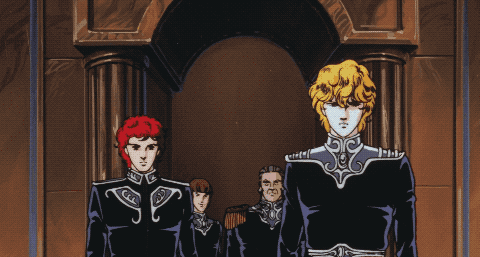
The relationship between war-prodigy Reinhard von Musel (later Lohengramm) and his loyal companion Siegfried Kircheis is central to the whole series, and one that we’ll be examining at great length and in excruciating detail. They’re a lot of what LoGH is “about,” and when we talk about queerness and heteronormativity in LoGH, we’re probably talking about Reinhard and Kircheis about 35% of the time, which is a lot considering how many queer characters and non-normative relationships are packed into this show.
Reinhard and Kircheis are in love; their relationship is one of the two Great Romances in LoGH. This will become increasingly clear as we get further into the main series, but even as early as “My Conquest” it’s demonstrated that the two are at the very least an insular pair—other characters understand that there are things Reinhard shares only with Kircheis, and we frequently see them communicate without speaking. LoGH’s beautiful art style, which is apparently an acquired taste (I guess some people have bad taste, too bad for them!), allows for an absurd level of detail in facial expressions, and the animators really make use of every single line and frame of animation. “My Conquest” establishes some of the visual vocabulary LoGH uses to describe/indicate romantic relationships in general, and Reinhard and Kircheis’s in particular, much of which happens directly on their faces.
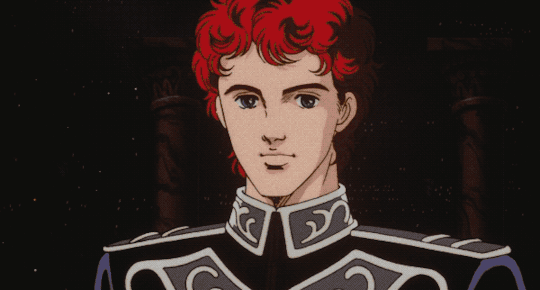
LoGH loves using every means at its disposal to convey information to the viewer, so pointed (coquettish?) looks like these are just as important as what characters say—if not more.
Of the two of them, Reinhard is flashier (we are frequently, FREQUENTLY reminded that he is literally the most beautiful person in the universe) and more ambitious than his counterpart, but Kircheis is either just or quite nearly as brilliant as Reinhard. Always a few steps above Kircheis in rank, Reinhard asks him for gut checks on his more controversial decisions, and it quickly becomes pretty obvious that Kircheis’s is the only opinion Reinhard trusts implicitly. There will be a lot more to say about them soon, but for now, just know that you're not imagining it: There's something going on between these two.
Queerness (in more general terms)
On that note, and given that almost all of the interactions between Reinhard and Kircheis (and many other pairs of characters) can be interpreted in at least two ways—one of which passes as heteronormative, and (at least) one of which decidedly does not—it would probably be helpful to talk about how we’ll be talking about queerness in LoGH.
A high percentage of queer content in today’s media is still conveyed via subtext, so it’s unsurprising that ~30 years ago (in Japan, but we’re not scholars of Japanese queer history, and god knows the west is also fucking terrible on this front), queer narratives could only exist behind a veneer of heteronormativity. LoGH’s veneer (or “surface reading” as we will probably call it more often) is mercifully thin, and only gets moreso over the course of the OVA, at which point Gaiden proceeds to smash it to bits.
But it is there! Nobody in Legend of Galactic Heroes is running around in a rainbow-striped pride jumpsuit shouting about how they are living their gay truth. (As we discuss at length in our FAQs, and will not discuss again after this post, if you need to hear the words “I’m Gay” uttered onscreen in order to believe that they’re true, turn back now!) The most striking and consistent example of this is the use of the word “friend” to describe people who are clearly romantic partners. This is a tried and true technique of fooling the straights into believing a thing is as heteronormative as they want it to be; therefore, we will be ignoring it in favor of analyzing what we see going on in front of our eyes.

When Reinhard refers to his "friends" as one of his concerns (the Japanese actually has no indication that this is plural, fwiw), the camera lingers on Kircheis, telling us in no uncertain terms what the actual topic of conversation is.
What is interesting about the heteronormativity-compliant “surface readings” of LoGH, though, is that the societies depicted in LoGH are just as heteronormative as those of the real world. This is barely even hinted at in “My Conquest,” but when we get to it, you’ll see a cool thing happen: Both LoGH’s creators and the characters they create use the same tools to navigate their respective heteronormative, homophobic societies, impatiently pushing past those who would stand in their way. Just as it is expedient for Reinhard to refer to Kircheis as his “friend” as they rise through the Empire’s ranks together, so the show’s creators refer to Kircheis as Reinhard’s “friend” so that they can tell the queer story they want to tell without worrying about barriers. LoGH is layered as hell, and it totally rules.
Reuental and Mittermeyer
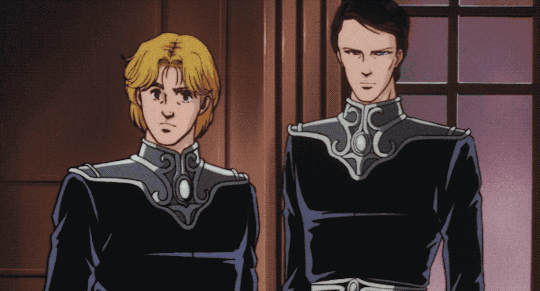
LoGH’s other Great Romance won’t be fleshed out for awhile, because that’s how long it takes for Reuental and Mittermeyer’s relationship to be relevant as anything other than background color. But even before it becomes central to the plot, you can keep an eye out for all the ways it’s suggested that these two have a relationship that’s not dissimilar from the one between Reinhard and Kircheis.
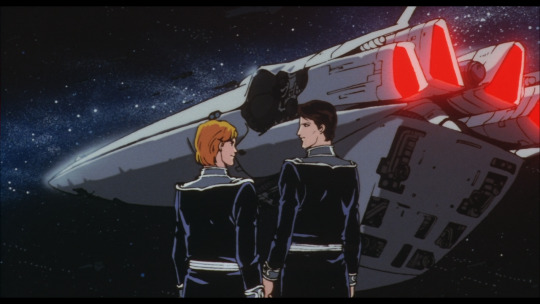
Like with Reinhard and Kircheis, the camera does a lot of the descriptive work for Reuental and Mittermeyer, like in this shot seemingly optimized to make it look like they're holding hands.
When they do eventually move into the foreground, Reuental and Mittermeyer are positioned as a counterpoint/foil to Reinhard and Kircheis, so taking note of all the times LoGH quietly but firmly tells us they’re a couple early on is both fun and helpful for understanding much of what happens later. You’ll be able to recognize these telling moments by the fact that it’s literally every time Reuental and Mittermeyer are both on your screen. It’s actually pretty unsubtle.
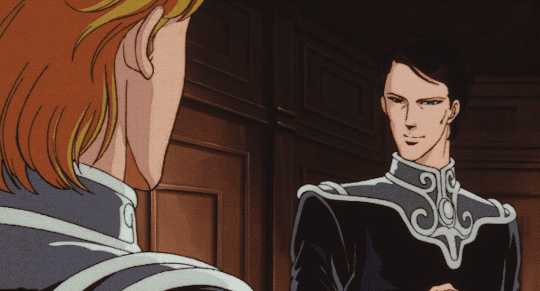
Yang
Ah, Yang Wenli, resident historian, political philosopher, and often moral center of the show. “My Conquest” quickly introduces us to several of Yang’s most salient features: he hates coffee (preferring tea, brandy, or ideally a mix of both), he seems to dislike chairs (preferring to hop up onto a table), he yearns to spend his time studying history, and while he feels rude not answering all the love letters he gets, he laments the cost of stamps and paper. (Keep this last one in mind—it is a nontrivial piece of the Yang Wenli puzzle, and actually a brilliant little bit of character building.)

It was with this shot that I personally (Rebecca) fell in love with both Yang and this show.
It also introduces us to one of his central conflicts: the tension between his natural laziness and lack of personal ambition on one hand, and his understanding that he has insight that many of the commanders above him lack that could potentially save lives or even help move the war toward a conclusion on the other. We see this in his guilt over not pushing harder for the Alliance fleet to ascend out of the trap Reinhard set for them on Legnica in the first half of the movie, and again as he sadly confesses to his friend Dusty that he’s been thinking for some time about how to end this war. From the beginning Yang’s character seems to be one of paradoxes: fighting a war despite believing it to be foolish; propelled to some kind of renown by the mysterious events at El Facil (that still cause him to receive a whole desk full of fanmail eight years later) despite his natural reticence; struggling with a feeling of obligation to shape the future when what he’s always been interested in is studying the past.
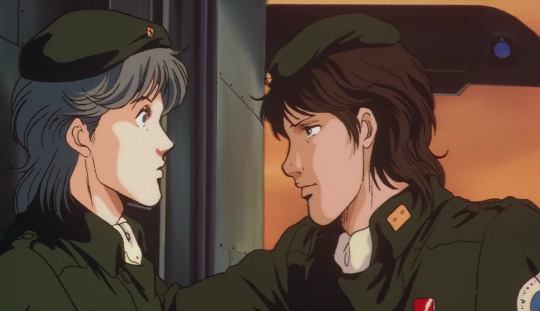
Another Yang paradox: being accidentally incredibly sexy while also completely oblivious about it… poor Dusty!
Worldbuilding

Because of its disproportionate focus on personal relationships and relatively lo-fi (for space, anyway) battles, it’s easy to forget that Legend of Galactic Heroes is science fiction—hard science fiction, in fact, meaning it’s plausible and well-researched, with no fantasy elements whatsoever. The world of LoGH is revealed to us slowly, almost exclusively via small matter-of-fact glimpses (I’ve always thought of it as “tip-of-the-iceberg storytelling,” no relation to this blog’s title!). Even the narrator’s pervasive presence is an integrated part of LoGH’s world: By the end of the OVA series, it’ll be pretty obvious whose voices have been merged, via future space academia, to form the narrator’s.
Right from the beginning, LoGH trusts its audience to put together scattershot pieces of information—the screens used for planning and fighting battles; Iserlohn’s thriving bar culture; holographic (pornographic?) magazines—into an increasingly coherent whole. This isn't often particularly important, thematically speaking, but the world's three-dimensionality adds yet another layer of realism to LoGH's already superbly-developed cast of characters. Also, the Future Technology has aged absurdly well, which is just really fucking cool.
Stray Tidbits

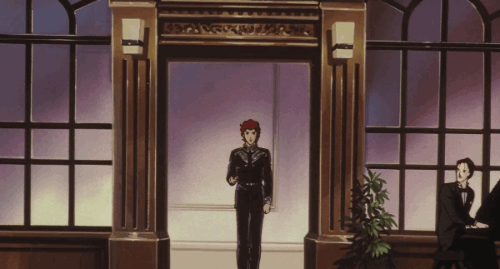
Captured above: one of the most badass moments in the entire show.
Wtf holographic porn magazine are those random soldiers reading…?



OOC alert: y’know when Reinhard is like “my life isn’t worth us losing this [basically meaningless] battle! Fire!” and then the actual captain of the Brunhilde stops him? Yeah as far as we can tell that is 100% not something Reinhard would do. Please ignore it. Reinhard has goals he would never abandon that easily.
OOC alert, Yang edition: We’ve never been able to figure out why Yang gives the fighter pilots a 500 dinar note. Yes, the point comes across that instead of giving them the reprimand they expect he plays along with their betting game, which is in character, but throwing money around in an ostentatious way isn’t. Anyway, there won't be another OOC alert until after we finish the OVA, so you can relax. We know you were worried.
And speaking of that betting scene, pay attention to the goofy redhead and the blonde; they’ll be back and they’re awesome.

#Legend of Galactic Heroes#Legend of the Galactic Heroes#My Conquest Is the Sea of Stars#author: co-authored#author: Rebecca#author: Elizabeth#Reinhard#Kircheis#Yang#Reuental#Mittermeyer#war#history#queerness#worldbuilding
26 notes
·
View notes
Text
FALSE:: MISTAKE: UNSUPPORTED ENCODING
Thanks a whole lot, I needed to increase an NTFS dividers situated on a compelling hard drive. So far, I have actually dealt with to hook up door with UNO, and also operate a demonstration code, adhering to Sparkfun's tutorial. Ha recibido numerosos premios, y el Pulitzer lo obtuvo en 1998 por un reportaje sobre los niños que sufren las adicciones de sus padres al liquor y las drogas "Orphans of Dependency (Huérfanos de Los Angeles adicción)". Peter Dahmen es un ingeniero del papel de Dortmund, Alemania. The disk received Hard drive Control as Dynamic" as well as Foreign" and will certainly not allow me to initialise it or even offer it a disk character. DOCTOR Jeremy Engel, a household professional along with St. Elizabeth who has actually ended up being a candid supporter for a health care response to the heroin epidemic, mentioned there is a great explanation for the slow-moving rate. I am actually safe below." It was actually a sentiment that she will repeat frequently to family and friends during her attend procedure. Una recopilación de algunos video recordings interesantes que han circulado recientemente, disadvantage algo de información sobre los propios videos y los artistas involucrados. In Cincinnati, an entry point for narcotics moving to Kentucky, the road dealerships biding coming from corners call it pet dog" or even dog" or pet food items." At times they market their product through barking at you. Su familia se trasladó a Génova en 1933 huyendo del nazismo, y luego pasaron a Madrid. Former as well as present hookeds in the Louisville residential areas, in Lexington and in North Kentucky said they purchased Suboxone from pals not to get higher yet to battle drawback when they tried to get sober by themselves. Fue una destacada figura en Los Angeles escena artística contemporánea de Quebec, asociada con los Automatistas. Entre sus estudiantes famosos se cuentan Fernand Khnopff, Kenyon Cox, Félix Vallotton, Ernst Friedrich von Liphart, Georges Rochegrosse, el pintor paisajista de origen escocés William Hart, Walter Lofthouse Administrator, y Edmund C. Tarbell, pintor impresionista estadounidense. I don't forget generating my mom's glass bottles for deposit as well as using the adjustment for the money sweet as well as TV 3D glasses for the 3D trend, you recognize, the FIRST time around. It confirms that I may receive time coming from the pong yet the potato chip time clock sketch is actually unable to fetch. In the mid '60s, the federal authorities chose that medication treatment need to become extra widely on call. I do not recognize that these exact same individuals would certainly possess been comfortable in the very early days creating films, since they were not concerning superheroes. Through Friday night, 3 times after leaving behind rehabilitation, Patrick's willpower presented indications of strain. And they're not always singable or Http://healthy-Strenght.Info danceable, definitely not through individuals like Fred Astaire and Gene Kelly as well as Cyd Charisse. Hey Joel, Thanks for the kind deal of a screen ... I will enjoy to but I only don't have the moment currently! Instead, Hollywood tells our company time and time again by TV series and also films that manly men-- the ones worth yearning after-- must be actually more powerful than us in every way. Sus fotografías se encuentran en las colecciones públicas permanentes del Museo de Arte Moderno de Lodz, Wroclaw, Varsovia, Legnica, Nueva York y en muchas colecciones privadas. Wrong stoppage, el número y el alcance de sus fotografías de Los Angeles vida de los pioneros en Nebraska, han hecho de ellas un valioso recurso para los estudiosos de ese período de Los Angeles historia. Hey, grateful you like it. 4 display screens would certainly need a fair bit of adjustments to the code, yet you could get the bigger 5mm LED versions of the display screens, I have the 3mm ones which are actually smaller sized.
0 notes
Text
宋淳祐元年1241年4月9日
蒙古帝國的軍隊在列格尼卡戰役中戰勝波蘭和軍事修士會的聯軍。
列格尼卡戰役(Battle of Legnica),亦稱列格尼茲戰役或萊格尼茨戰役等,爆發於1241年4月9日,地點在現波蘭境內列格尼卡的一條小村莊。蒙古軍在此戰擊敗了波德聯軍。
十三世紀戰場上的蒙古重騎兵。
交戰雙方是拔都統率,速不台指揮的蒙古軍隊與西里西亞公爵亨利二世率領下的波蘭軍隊。兵力方面,蒙古軍大約有8,000 - 20,000人(2個圖們);波蘭聯軍則大約有25,000人。這支聯軍的士兵分別來自波蘭自身的軍隊、聖殿騎士團、醫院騎士團和條頓騎士團。傷亡人數方面,蒙古軍死傷人數暫時無法得知。
雖然蒙古人取得了此戰的勝利,但是由於窩闊台汗去世的消息傳來,他們不得不折返回東方去選出新任大汗,於是列格尼卡也成為蒙古西征中所到達的最西方。

0 notes
Text
Michael Petry – The Art of Being

When British based artist Michael Petry comes to town the valley takes notice. Innovative and always pushing the envelope Michael was born in El Paso, Texas, in 1960 and has lived in London since 1981. He studied at Rice University, Houston (BA), London Guildhall University (MA), and has a Doctor in Arts from Middlesex University. He is an artist, author and curator.
Michael’s latest show will open at Melissa Morgan Fine Art Gallery on January 6 and will run through February 6, 2017. Michael’s works are included in collections throughout the world including the Palm Springs Art Museum; Museum of Arts and Design, New York City; Museum of Fine Arts, Houston, the Toledo Museum of Art, the British Museum, London; The National Collection, UK, the Kunst und Ausstellungshalle der Bundesrepublick Deutschland, Bonn, the Bellerive Museum, Zurich, The New Art Gallery Walsall, UK, Rogaland Kunstmuseum, Stavanger, Norway, The Gallery of Art, Legnica, Poland and the Leopold Hoesch Museum, Düren, Germany.
Lest We Forget the Gods continues his performance art work Libation to Eros that was shown at the Palm Springs Art Museum, Palm Desert Campus in 2015. In the original performance Michael shot a red arrows into a wall of cork while telling the story of Eros, the Greek God of desire and love. He shot one arrow for each year of his life. Simultaneously he intoned a classical tale, mixed with his own story. The juxtaposition of the arrows and sound created a powerful performance that reinforced the arrow metaphor – that the arrow, like loves can bring with it pain and pleasure and that the arrow always brings about change. “It is this fear of the chaos of love that I hope to tap into,” noted Michael.
Lest We Forget the Gods will include a series of large-scale Libation paintings that were made during a residency at the Coachella Valley Art Center. These works form a series called The Battle of the Gods and the Titans, and each one was made by Michael firing real arrows into the canvas.
He will also present sculptural works in bronze and porcelain. A full life sized solid bronze arrow called Libation to Eros will accompany two libation bowls made for Michael in Jingdezhen, the 2000-year-old porcelain center of 2000 years. Libation to Apollo is a one meter (in diameter) gold bowl that will be filled with white wine and Libation to Selene (the moon goddess) will be filled with red wine. The exhibition will also be accompanied by porcelain wall work made up of 9 silver porcelain stars. It will also include Constellation; a series is based on the astrological signs based on the stars.
What makes Michael’s work unique is his ability to work well with other artists and craftsman. Where some artist will take create for the complete creation Michael has always acknowledged that some work does take a village. Michael’s book The Art of Not Making: The New Artist/Artisan Relationship looks at artists who have work produced for them by artisans.
For more information visit www.michaelpetry.net or www.melissamorganfineart.com
0 notes